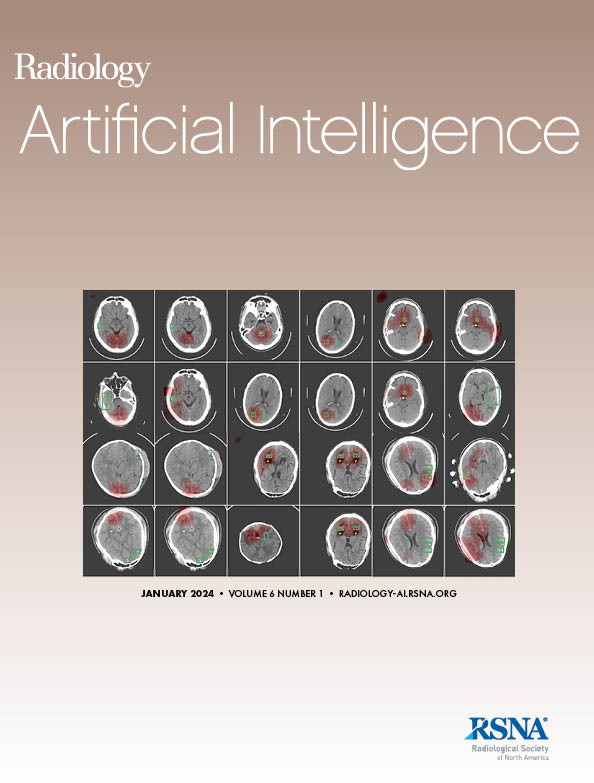Predicting Major Adverse Cardiac Events Using Deep Learning-based Coronary Artery Disease Analysis at CT Angiography.
IF 13.2
Q1 COMPUTER SCIENCE, ARTIFICIAL INTELLIGENCE
Jin Young Kim, Kye Ho Lee, Ji Won Lee, Jiyong Park, Jinho Park, Pan Ki Kim, Kyunghwa Han, Song-Ee Baek, Dong Jin Im, Byoung Wook Choi, Jin Hur
求助PDF
{"title":"Predicting Major Adverse Cardiac Events Using Deep Learning-based Coronary Artery Disease Analysis at CT Angiography.","authors":"Jin Young Kim, Kye Ho Lee, Ji Won Lee, Jiyong Park, Jinho Park, Pan Ki Kim, Kyunghwa Han, Song-Ee Baek, Dong Jin Im, Byoung Wook Choi, Jin Hur","doi":"10.1148/ryai.240459","DOIUrl":null,"url":null,"abstract":"<p><p>Purpose To evaluate the predictive value of deep learning (DL)-based coronary artery disease (CAD) extent analysis for major adverse cardiac events (MACEs) in patients with acute chest pain presenting to the emergency department (ED). Materials and Methods This retrospective multicenter observational study included consecutive patients with acute chest pain who underwent coronary CT angiography (CCTA) at three institutional EDs from January 2018 to December 2022. Patients were classified as having no CAD, nonobstructive CAD, or obstructive CAD using a DL model. The primary outcome was MACEs during follow-up, defined as a composite of cardiac death, nonfatal myocardial infarction, and hospitalization for unstable angina. Cox proportional hazards regression models were used to evaluate the predictors of MACEs. Results The study included 408 patients (224 male; mean age, 59.4 years ± 14.6 [SD]). The DL model classified 162 (39.7%) patients as having no CAD, 94 (23%) as having nonobstructive CAD, and 152 (37.3%) as having obstructive CAD. Sixty-three (15.4%) patients experienced MACEs during follow-up. Patients with MACEs had a higher prevalence of obstructive CAD than those without (<i>P</i> < .001). In the multivariate analysis of model 1 (clinical risk factors), dyslipidemia (hazard ratio [HR], 2.15) and elevated troponin T levels (HR, 2.13) were predictive of MACEs (all <i>P</i> < .05). In model 2 (clinical risk factors plus DL-based CAD extent), obstructive CAD detected by the DL model was the most significant independent predictor of MACEs (HR, 88.07; <i>P</i> < .001). Harrell C statistic showed that DL-based CAD extent enhanced the risk stratification beyond clinical risk factors (Harrell C statistics: 0.94 vs 0.80, <i>P</i> < .001). Conclusion DL-based detection of obstructive CAD demonstrated stronger predictive value than clinical risk factors for MACEs in patients with acute chest pain presenting to the ED. <b>Keywords:</b> Cardiac, CT-Angiography, Outcomes Analysis © RSNA, 2025 See also commentary by Reddy in this issue.</p>","PeriodicalId":29787,"journal":{"name":"Radiology-Artificial Intelligence","volume":" ","pages":"e240459"},"PeriodicalIF":13.2000,"publicationDate":"2025-05-01","publicationTypes":"Journal Article","fieldsOfStudy":null,"isOpenAccess":false,"openAccessPdf":"","citationCount":"0","resultStr":null,"platform":"Semanticscholar","paperid":null,"PeriodicalName":"Radiology-Artificial Intelligence","FirstCategoryId":"1085","ListUrlMain":"https://doi.org/10.1148/ryai.240459","RegionNum":0,"RegionCategory":null,"ArticlePicture":[],"TitleCN":null,"AbstractTextCN":null,"PMCID":null,"EPubDate":"","PubModel":"","JCR":"Q1","JCRName":"COMPUTER SCIENCE, ARTIFICIAL INTELLIGENCE","Score":null,"Total":0}
引用次数: 0
引用
批量引用
Abstract
Purpose To evaluate the predictive value of deep learning (DL)-based coronary artery disease (CAD) extent analysis for major adverse cardiac events (MACEs) in patients with acute chest pain presenting to the emergency department (ED). Materials and Methods This retrospective multicenter observational study included consecutive patients with acute chest pain who underwent coronary CT angiography (CCTA) at three institutional EDs from January 2018 to December 2022. Patients were classified as having no CAD, nonobstructive CAD, or obstructive CAD using a DL model. The primary outcome was MACEs during follow-up, defined as a composite of cardiac death, nonfatal myocardial infarction, and hospitalization for unstable angina. Cox proportional hazards regression models were used to evaluate the predictors of MACEs. Results The study included 408 patients (224 male; mean age, 59.4 years ± 14.6 [SD]). The DL model classified 162 (39.7%) patients as having no CAD, 94 (23%) as having nonobstructive CAD, and 152 (37.3%) as having obstructive CAD. Sixty-three (15.4%) patients experienced MACEs during follow-up. Patients with MACEs had a higher prevalence of obstructive CAD than those without (P < .001). In the multivariate analysis of model 1 (clinical risk factors), dyslipidemia (hazard ratio [HR], 2.15) and elevated troponin T levels (HR, 2.13) were predictive of MACEs (all P < .05). In model 2 (clinical risk factors plus DL-based CAD extent), obstructive CAD detected by the DL model was the most significant independent predictor of MACEs (HR, 88.07; P < .001). Harrell C statistic showed that DL-based CAD extent enhanced the risk stratification beyond clinical risk factors (Harrell C statistics: 0.94 vs 0.80, P < .001). Conclusion DL-based detection of obstructive CAD demonstrated stronger predictive value than clinical risk factors for MACEs in patients with acute chest pain presenting to the ED. Keywords: Cardiac, CT-Angiography, Outcomes Analysis © RSNA, 2025 See also commentary by Reddy in this issue.
基于深度学习的冠状动脉疾病CT血管造影分析预测主要心脏不良事件。
“刚刚接受”的论文经过了全面的同行评审,并已被接受发表在《放射学:人工智能》杂志上。这篇文章将经过编辑,布局和校样审查,然后在其最终版本出版。请注意,在最终编辑文章的制作过程中,可能会发现可能影响内容的错误。目的评价基于深度学习(DL)的冠状动脉疾病(CAD)程度分析对急诊科(ED)急性胸痛患者重大不良心脏事件(mace)的预测价值。材料和方法本回顾性多中心观察性研究纳入了2018年1月至2022年12月在三家机构急诊科接受冠状动脉CT血管造影(CCTA)的急性胸痛患者。使用DL模型将患者分为无CAD、非阻塞性CAD和阻塞性CAD。主要终点为随访期间的mace,定义为心源性死亡、非致死性心肌梗死和因不稳定心绞痛住院的复合指标。采用Cox比例风险回归模型评价mace的预测因子。结果纳入408例患者,其中男性224例;平均年龄59.4±14.6岁)。DL模型将162例(39.7%)患者分类为无CAD, 94例(23%)为非阻塞性CAD, 152例(37.3%)为阻塞性CAD。随访期间63例(15.4%)患者出现mace。有mace的患者发生阻塞性CAD的比例高于无mace的患者(P < 0.001)。在多因素分析模型1(临床危险因素)中,血脂异常(危险比[HR]为2.15)和肌钙蛋白- t升高(危险比[HR]为2.13)预测mace(均P < 0.05)。在模型2(临床危险因素+ DL-based CAD程度)中,DL模型检测出的阻塞性CAD是mace最显著的独立预测因子(HR, 88.07, P < 0.001)。Harrell’s c -统计结果显示,基于dl的CAD程度增强了危险分层,超出了临床危险因素(Harrell’s c -统计值:0.94比0.80,P < 0.001)。结论基于dl的阻塞性CAD检测对急诊科急性胸痛患者mace的预测价值高于临床危险因素。©RSNA, 2025。
本文章由计算机程序翻译,如有差异,请以英文原文为准。
来源期刊
期刊介绍:
Radiology: Artificial Intelligence is a bi-monthly publication that focuses on the emerging applications of machine learning and artificial intelligence in the field of imaging across various disciplines. This journal is available online and accepts multiple manuscript types, including Original Research, Technical Developments, Data Resources, Review articles, Editorials, Letters to the Editor and Replies, Special Reports, and AI in Brief.

 求助内容:
求助内容: 应助结果提醒方式:
应助结果提醒方式:


